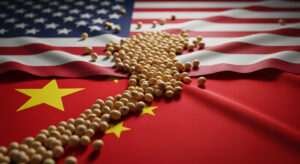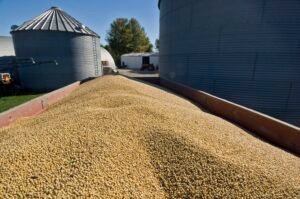By Jacquie Holland, ASA Economist

China’s 20% retaliatory tariff on U.S. soybeans has caused major problems for producers this fall. Historically, China is the top buyer of global and U.S. soybeans, and the rest of the competition is not even close. In Marketing Year 2023/24, the U.S. shipped nearly 25 MMT of soybeans to China while the European Union – the next largest buyer of U.S. soybeans – can barely buy one-fifth (4.9MMT) of China’s soybean purchases.
Soybean producers in the U.S. had not recovered from the 2018 trade war fallout when a new set of retaliatory tariffs were imposed by China in 2025. The added tariff costs generally pushed Brazilian soybean costs lower than U.S. prices when the tariff was factored in during the trade war.
As a result, China’s soybean purchases from Brazil ballooned while its imports of U.S. soybeans declined. As China’s soybean purchases from Brazil grew, low production costs, favorable currency exchange rates, and additional infrastructure investments from China expanded profits for Brazilian producers, pushing more soybean acres into production in Brazil.
With the addition of China’s 20% retaliatory tariffs, U.S. soybean prices are more expensive to China than South American prices, even though market prices for U.S. beans are currently quoted below their South American counterparts. Additionally, China has signaled that soybean purchases are conditional on tariff removal by the United States. This issue has led China to not purchase any U.S. soybeans to be harvested during the current 2025/26 marketing year through early October.
 Through the early weeks of U.S. harvest season, there was little evidence to indicate China could be convinced to buy U.S. soybeans. Brazil continued shipping monthly record volumes of soybeans through the late summer months, primarily to China, following a record crop. Economic turmoil concurrent with a U.S. Treasury bailout in Argentina led to an “export tax holiday,” which resulted in China buying $5.6 billion worth of Argentine soy products in late September. Plus, China has also been courting soybean sellers in Uruguay, Central Asia and Eastern Europe.
Through the early weeks of U.S. harvest season, there was little evidence to indicate China could be convinced to buy U.S. soybeans. Brazil continued shipping monthly record volumes of soybeans through the late summer months, primarily to China, following a record crop. Economic turmoil concurrent with a U.S. Treasury bailout in Argentina led to an “export tax holiday,” which resulted in China buying $5.6 billion worth of Argentine soy products in late September. Plus, China has also been courting soybean sellers in Uruguay, Central Asia and Eastern Europe.
The window for potential U.S. soybean exports to go to China narrowed this fall while China remained absent from the U.S. market. Through early October, it was estimated China had secured enough soybean supplies for its domestic crush markets through at least early December. Historically, China would rely heavily on U.S. soybeans between October to February before turning to cheaper Brazilian supplies, which hit export markets by March. That means without other suppliers, China may only book U.S. soybean exports through part of December and January.
The discounted U.S. prices could boost purchase volumes from other countries, though the purchase volumes would not fully offset Chinese purchases. Additionally, the extra supplies could be partially – though not fully – consumed by the growing crush industry if EPA finalizes biofuels policies in a manner which would favor increased soybean oil consumption for renewable diesel production. However, that is a long-term market development play and does not solve the short-term issue posed by the lack of sales to China.
These opportunities should be met with a degree of nuance. No other end user can consume the same volume of U.S. soybeans as Chinese export purchases. Ideally, U.S. soybean farmers would receive much higher prices from all end users with China’s presence in U.S. markets, not its absence.
U.S. soybean growers are stuck between a rock and a hard place as harvest winds down this fall. The wide current futures price spread suggests few international buyers are interested in freshly harvested U.S. soybeans this fall.
Higher prices for future delivery months are currently being quoted by the market and incentivizing farmers to store soybeans at harvest. But without the certainty of a trade deal, farmers could still end up earning cash prices in spring and summer delivery months below the cost of production while also incurring steep storage expenses in the continued absence of Chinese demand.
The post The Soybean Export Gap Hurting U.S. Farmers – Farmers can’t afford casual trade policies when China walks away from U.S. soy appeared first on American Soybean Association.














